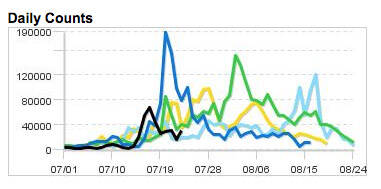Last week, fish counts from the State Department of Fish and Game showed a sudden influx of sockeye salmon in the Kenai and Kasilof Rivers, up tenfold from the numbers only two days before. The spike came at relatively the same time that a massive upward trend was seen for the species in last year’s daily counts for the two rivers, but this year’s numbers have trended back downward.
On the Kenai River, since the start of the late run on July 1, around 393,000 sockeye have been counted by sonar as of Sunday. That number lags behind each of the last four years at the same time in their runs. Last year at this time, 854,000 sockeye had been counted, 461,000 more than this year.
The daily counts have largely held around 30,000 per day on the Kenai River since July 19. So far this year, the highest count was 69,000 sockeye, counted July 17.
The department still expects the sockeye run to exceed expectations. The most recent Northern Kenai Fishing Report, from July 20, said sockeye salmon fishing “should improve.” Last week, two Emergency Orders were issued increasing bag limits for sockeye salmon on the river and removing time restrictions from the Kenai River personal use dipnet fishery. Those emergency orders both cited department predictions for a run that entirely surpasses the escapement goal for the species, which is 750,000-1.3 million.
On the Kasilof River, counts have ranged from 12,000 to 18,000 since July 18. So far this year, the peak count was 60,000 fish counted by sonar on July 16.
To date, 476,000 sockeye have been counted on the Kasilof River. That number surpasses the fish counts at the same time in 2021, 2020 and 2019. That number falls more than 200,000 behind the counts from last year — where at this time 701,000 sockeye had been counted.
The late run for the Russian River only started July 15. The largest day for the fish counts was Saturday, when 1,200 sockeye were counted. To date, 7,000 fish have passed, falling behind the last four years.
The department said Russian River sockeye fishing “is expected to improve.”
The next local fishing report will be published by the department on Thursday.
More information about fish counts, regulations and availability can be found at adfg.alaska.gov.
Reach reporter Jake Dye at jacob.dye@peninsulaclarion.com.

